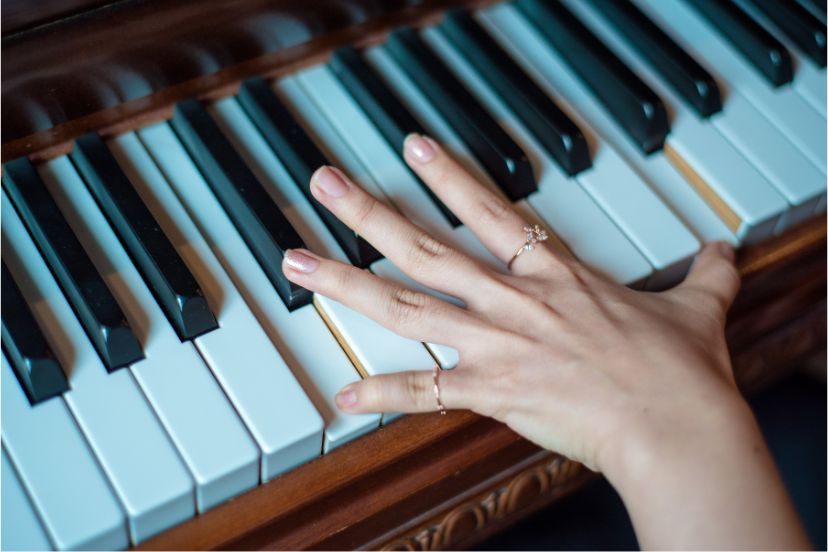For those looking to learn piano in a creative and enjoyable way, Creative Piano Academy offers…
Hand Stretches for Piano: Enhance Your Playing Technique

Hand stretches for piano are an essential part of any pianist’s warm-up routine. Whether you’re a beginner just starting to explore the world of piano music or a professional, these exercises can significantly improve your overall performance.
The Importance of Hand Stretches
Hand stretches are not merely about warming up your fingers and wrists. They also engage your forearms, upper arm, and even your body posture, all of which contribute to your ability to play piano more effectively and comfortably. Regular practice of such exercises can enhance your finger strength, prevent injuries, and ultimately enable you to play longer and more complex pieces of sheet music.
Starting Your Warm-Up Routine
Before you begin playing, it’s important to sit properly at your musical instrument. Your back should be straight, and your arms relaxed at your sides. Start by breathing deeply a few times to get your blood flowing and your body ready for the warm-ups.
Basic Hand Stretches for Piano
The first exercise before you begin to play piano involves a simple wrist bend. Extend one arm in front of you (left or right arm) with the palm facing upward. With your other hand, gently press on your fingers so that they point towards the floor. Hold this stretched position for a few seconds before releasing. Repeat this with the other arm, making sure to breathe deeply throughout the exercise.
Next, place your palms facing each other, fingers stretched outward. Gently pull your hands apart while keeping your fingers flat and touching. This exercise helps prepare your fingers for the spread needed when playing chords on the piano.
Advanced Hand Stretches
Once you’re comfortable with basic hand stretches, you can move onto more advanced exercises. One such exercise involves the ‘piano practice spider.’ Here, you start with your thumb and index finger pinching together, then move to the next fingers in the same direction, like a spider crawling across your hand.
Another advanced stretch involves holding your hand in front of you, fingers spread wide, and then pulling gently on each finger with your other hand. When you pull gently like this, it helps to increase flexibility and strength in your individual fingers, enhancing your piano playing technique.
Also, consider the ‘palm flat’ exercise. Here, you place one hand flat on a surface, fingers spread wide. Then, lift one finger at a time while keeping the other fingers flat. This exercise is particularly useful for improving finger independence, which is crucial when playing the piano.
Integrating Stretches into Your Practice Sessions
It’s important to incorporate these hand stretches into your regular piano practice routine. Before you start playing, spend a few minutes warming up your hands and wrists. You can also use these exercises as a break during longer practice sessions.
Remember, progress may be slow at first. However, if you’re consistent with your warm-up routine, you’ll soon notice how much progress you’ve made in your overall piano technique.
Additional Tips
In addition to hand stretches, there are other ways to improve your piano playing. For example, pay attention to your hand position when playing. Your fingers should be curved, not flat, and your wrist should be level with the keyboard.
Also, ensure that you’re using the correct fingers for each note, which you can usually find in your sheet music. Starting on Middle C and progressively reaching for the next note, most beginners (even those with small hands) can comfortably stretch across three notes, but reaching for the fourth note is when some begin to feel a little discomfort – so be disciplined, and remember your fingerings!
Another tip is to use YouTube videos as a resource. Many professional pianists share their warm-up routines and specific exercises online, providing valuable insight into their own hands-on experience.

FAQs: Stretches for Playing Piano
Why is it important to do hand stretches before playing the piano?
Hand stretches help to warm up the muscles and prevent injuries while playing the piano.
How often should I do hand stretches during practice time?
It’s recommended to incorporate hand stretches at the beginning and end of each practice session, as well as taking breaks to stretch during longer playing sessions.
What are some warm up exercises I can do before playing the piano?
Some warm up exercises include rolling your wrists and fingers outward and inward, gently pulling fingers towards your wrist, and stretching your arms and forearms.
Should I focus on stretching my left hand or right hand more?
It’s important to stretch both hands equally to prevent imbalance and avoid injuries.
How long should I hold each stretch for?
Hold each stretch for a few seconds, breathing deeply and relaxing the body.
Can I perform hand stretches on a flat surface?
Yes, you can perform hand stretches on a flat surface such as a table or desk, making sure to keep the fingers straight and gently pulling them towards the wrist.
Should I practice hand exercises with the same fingers every time?
It’s important to switch up the fingers you’re stretching and exercising to prevent overuse and promote balance.
What piano exercises incorporate hand stretches?
Exercises such as scales and arpeggios incorporate hand stretches and finger flexibility.
How do I stretch my thumb while playing the piano?
To stretch your left or right thumb, place it on a flat surface and gently push it towards your wrist, holding for a few seconds before releasing. Rest, and then switch hands.
What’s the next tip after stretching before playing the piano?
After stretching, start playing with a relaxed body and gradually increase tempo and difficulty as you warm up. Remember to take breaks and stretch as needed throughout your practice session.
Summary
Routinely stretching your fingers and hands can significantly enhance your piano playing technique, allowing you to play more complex pieces with ease. By incorporating these exercises into your regular practice sessions, you can improve your finger strength, increase your flexibility, and prevent potential injuries.
Remember, it’s not about how fast you can play but how well you can express the music. So, take your time, breathe deeply, and let your fingers dance on the keys.
Whether you are a beginner just learning to play piano or a seasoned pianist, these exercises can make a significant difference in your playing. So next time before you sit to practice or perform, remember to stretch, warm-up, and prepare your body for the musical journey ahead.



